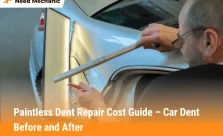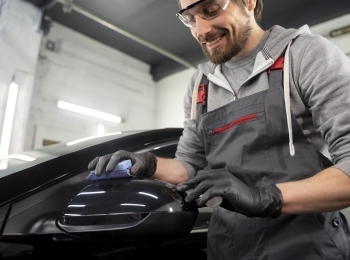You can fix a small dent in your car at home by using simple methods like heating and cooling the panel, pulling with a plunger, pouring boiling water on plastic bumpers, or using an affordable dent puller kit. These approaches work without special skills and can restore your car’s look while saving money on body shop repairs.
Dents are frustrating but common. Shopping carts, hail, or a light bump in a parking lot can all leave behind a small mark. While it may seem like an expensive repair, many dents can be safely fixed in your driveway with tools you already have. In this guide, we’ll walk through proven DIY techniques, explain when each method works best, and show you how to finish the repair so your car looks as good as possible.
Table of Contents
Understanding Small Car Dents
Before you start any repair, it’s important to understand the type of dent you’re dealing with. Not all dents behave the same way, and the repair method that works on one may not work on another. The size, depth, location, and even the material of the panel all play a role in how easy the dent is to fix at home.
Common Types of Small Dents
- Shallow surface dents – These are the most common, caused by light bumps. They don’t break the paint and are easiest to fix.
- Round or dimple dents – Often caused by hail, balls, or stones. They may look minor, but can be stubborn if deep.
- Crease dents – These happen when something long scrapes across your car. They’re harder to fix at home, but still possible with the right tools.
Things to Check Before Repair
- Is the paint cracked? If yes, fixing the dent won’t prevent rust unless the paint is also touched up.
- Is the dent on a corner or edge? These areas are stronger and more challenging to reposition.
- Is it on plastic or metal? Car bumpers are often plastic, while doors and fenders are metal. Some methods work better depending on the material.
Tools and Materials You May Need
Most dent repairs require only basic supplies. You may already have many of these at home, and others are affordable to buy online or at a hardware store.
- Hair dryer or heat gun
- Compressed air can
- Plunger (clean, small cup type works best)
- Boiling water (for plastic bumpers)
- Rubber mallet and wooden block
- Suction cup dent puller kit
- Glue puller kit (optional but effective for tougher dents)
- Microfiber cloths for cleaning
- Car wax or polish for finishing
Method 1: Using Heat and Cold to Pop Out the Dent
One of the easiest and most popular methods for fixing a small dent at home is by using a combination of heat and cold. This method works because metal expands when heated and contracts when cooled. By quickly changing the temperature of the dented area, the panel often “snaps” back into its original shape. The best part? You don’t need expensive tools, just a household hair dryer and a can of compressed air.
Step-by-Step Process
1. Clean the area first.
Before you begin, make sure the dent and surrounding surface are clean. Dirt, grease, or dust can prevent even heating and cooling. Use a damp cloth or mild car cleaner to wipe the area, then dry it with a microfiber towel.
2. Apply heat.
Turn on your hair dryer (or a heat gun on the lowest setting if you have one) and aim it directly at the dent. Hold it a few inches away and heat the area for about 30 to 60 seconds. The goal is to warm the metal enough that it becomes slightly more flexible, but not so hot that it damages the paint.
3. Blast with cold.
Immediately grab a can of compressed air and hold it upside down so that liquid carbon dioxide sprays out. Direct it right onto the heated dent. The rapid drop in temperature causes the metal to contract quickly, which often forces the dent to pop outward.
4. Check your progress.
After the cooling spray, step back and see if the dent has improved. Sometimes it pops back out on the first try, but other times you may need to repeat the heating and cooling cycle two or three times for the best results.
When This Method Works Best
The heat-and-cold method is most effective on small to medium dents located on flat metal surfaces, such as car doors, hoods, or fenders. It works especially well if the dent hasn’t cracked or chipped the paint. However, it is less reliable on deep dents or dents near reinforced edges, where the metal is stronger and less flexible.
Why Choose This Method
People like this technique because it is fast, inexpensive, and doesn’t require any special tools. If you already have a hair dryer at home, the only thing you may need to purchase is a can of compressed air, which is inexpensive and widely available. It’s also a safer method for beginners compared to using hammers or pulling kits.
Method 2: The Plunger Technique
Believe it or not, one of the simplest tools for fixing a small dent in your car is a regular household plunger. The reason it works is simple: a plunger creates suction. When applied correctly, that suction can pull the dented metal outward and restore the surface closer to its original shape. While this method won’t solve every dent, it’s often the first and easiest technique to try at home because it doesn’t require any special equipment.
Step-by-Step Process
1. Moisten the plunger and dent area.
For the suction to work, the plunger needs to form a tight seal with the car’s surface. Splash a little water or soapy solution on both the plunger cup and the dented panel. This reduces air gaps and helps create stronger suction.
2. Place the plunger firmly over the dent.
Position the plunger so it covers the dent completely. If the dent is larger, a standard toilet plunger might work best. For smaller dents, a sink plunger with a narrow cup can be more effective.
3. Pull with steady pressure.
Grip the handle and pull outward with slow, even pressure. The key is to avoid jerking motions. Gentle, steady pulls give the metal a chance to move back into place without stressing the paint.
4. Repeat several times.
It’s rare for the dent to pop out on the first attempt. You may need to repeat the process a few times, slightly repositioning the plunger as needed, until you see improvement.
5. Inspect your results.
Once the dent looks better, clean the area again and check it in natural light. Sometimes the plunger removes the dent completely, while other times it reduces it enough that it becomes barely noticeable.
You may read: Types of Front Bumpers
When This Method Works Best
The plunger technique is ideal for shallow dents on wide, flat panels like car doors, hoods, or fenders. It’s not as effective on sharp crease dents, edges, or reinforced body lines where the metal is less flexible. However, for round or shallow dents, it can work surprisingly well.
Why Choose the Plunger Method
- Low cost – Most people already have a plunger at home, making it essentially free.
- No special skills required – Anyone can try this method with minimal effort.
- Safe for paint – As long as you use steady pressure, it won’t damage your car’s finish.
While it may not be the ultimate fix for every type of dent, the plunger method is a quick, safe, and cost-effective first step for anyone learning how to fix small dents at home.
Method 3: Using a Dent Puller Kit
If simple home tricks like heat or plungers don’t solve the problem, the next step is to use a dent puller kit. These kits are affordable, widely available online and in auto stores, and designed specifically for small to medium dents. They give you more control than household tools and can restore your car’s surface without the cost of a body shop.
Dent puller kits generally come in two main types:
- Suction-based pullers – These work much like a heavy-duty plunger. They create strong suction and can pull out dents on flat panels.
- Glue-based pullers – These are more advanced and often more effective. They use special hot glue to attach a pulling tab directly to the dent. A tool then applies controlled pressure to gradually lift the dent back into place.
Step-by-Step Process (Glue Puller)
1. Clean the dent area.
Use soap and water or rubbing alcohol to remove dirt, grease, or wax. A clean surface helps the glue stick properly and ensures better results.
2. Apply glue to the pulling tab.
Heat up the glue gun (usually included in the kit) and place a small amount of hot glue on the flat side of the pulling tab. Quickly press the tab onto the center of the dent and let it cool for a minute until it bonds securely.
3. Attach the pulling tool.
Once the glue is set, connect the dent puller tool to the tab. Tighten or squeeze the handle gently to apply pulling force. The goal is to pull gradually; too much force at once could create a high spot or crack the glue bond.
4. Remove the glue and check progress.
After pulling, use rubbing alcohol to loosen the glue and remove the tab. Inspect the panel to see how much the dent has improved. If it’s not fully gone, repeat the process with a new tab until you’re satisfied.
When This Method Works Best
Dent puller kits are especially effective on stubborn dents that didn’t respond to heat, cold, or plunger methods. They work well on flat metal surfaces like doors, hoods, and trunks. However, they are less effective on sharp creases or edges where the metal is reinforced.
Why Choose a Dent Puller Kit
- Affordable solution – Kits typically cost less than a single trip to a body shop.
- Reliable results – They give you more pulling power and precision than improvised methods.
- Paint-safe – If used correctly, glue tabs and suction cups won’t damage the paint.
For many car owners, dent puller kits strike the right balance between cost, ease of use, and effectiveness. If household tricks don’t do the job, this is often the next best step before considering professional repair.
Benefits of Fixing Small Dents Yourself
- Save money – Body shop repairs can cost $150-$500 for small dents, while DIY often costs little to nothing.
- Protect car value – Even minor dents reduce resale value.
- Prevent further damage – Fixing dents quickly lowers the risk of rust or worsening cracks.
- Boost confidence – Learning simple car maintenance gives you more control and reduces dependence on costly repairs.
Conclusion
Small dents don’t have to stay on your car or cost a fortune to repair. You can fix them at home with simple methods like heat and cold, a plunger, boiling water for plastic bumpers, a dent puller kit, or gentle tapping from behind. Choosing the right method for the dent’s size and location makes the process easier and more effective.
Learning how to fix a small dent in your car at home saves money, protects your car’s value, and prevents further damage. With a little patience and the right approach, you can restore your vehicle’s appearance and enjoy the satisfaction of doing it yourself.
FAQs
Can I fix a small dent in my car at home?
Yes. You can fix small dents using simple methods like a plunger, heat and cold, boiling water for plastic bumpers, or a dent puller kit. These methods are safe and inexpensive if the paint isn’t cracked.
What is the easiest way to remove a small car dent?
The plunger method is the easiest for beginners. It uses suction to pull the dent outward and works best on shallow dents in flat areas like doors or fenders.
Does hot water really remove dents?
Hot water softens plastic bumpers, making dents easier to push out from behind. It doesn’t work as well on metal panels but is very effective on plastic.
Will a hair dryer and compressed air fix dents?
Yes, heating the dent with a hair dryer and then spraying compressed air creates rapid expansion and contraction. This often pops the dent back out on metal panels.
Are dent puller kits worth it?
Yes. Dent puller kits provide more power and control than home tricks. They are especially useful for deeper dents that plungers or heat methods can’t fix.
Can small dents cause long-term damage?
If the paint is cracked or chipped, dents can lead to rust over time. Fixing dents early prevents further damage and protects your car’s value.
How much does it cost to fix a dent at home?
Most home dent repairs cost little to nothing. A plunger or boiling water costs nothing extra, while dent puller kits usually range from $20 to $50.
When should I see a professional for dent repair?
If the dent is deep, near an edge, or the paint is cracked, it’s best to visit a professional. Paintless dent repair (PDR) is often recommended in these cases.













Leave a Reply